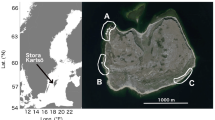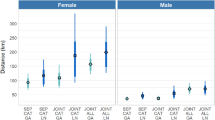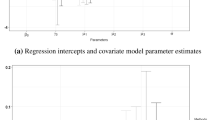Abstract
The concept of Darwinian fitness is central in evolutionary ecology, and its estimation has motivated the development of several approaches. However, measuring individual fitness remains challenging in empirical case studies in the wild. Measuring fitness requires a continuous monitoring of individuals from birth to death, which is very difficult to get in part because individuals may or may not be controlled at each reproductive event and recovered at death. Imperfect detection hampers kee** track of mortality and reproductive events over the whole lifetime of individuals. We propose a new statistical approach to estimate individual fitness while accounting for imperfect detection. Based on hidden process modelling of longitudinal data on marked animals, we show that standard metrics to quantify fitness, namely lifetime reproductive success, individual growth rate and lifetime individual contribution to population growth, can be extended to cope with imperfect detection inherent to most monitoring programs in the wild. We illustrate our approach using data collected on individual roe deer in an intensively monitored population.

Similar content being viewed by others
References
Andersen R, Gaillard JM, Linnell JDC, Duncan P (2000) Factors affecting maternal care in an income breeder, the European roe deer. J Anim Ecol 69:672–682
Barbraud C, Weimerskirch H (2005) Environmental conditions and breeding experience affect costs of reproduction in blue petrels. Ecology 86:682–692
Beauplet G, Barbraud C, Dabin W, Küssener C, Guinet C, Benton T (2006) Age-specific survival and reproductive performances in fur seals: evidence of senescence and individual quality. Oikos 430–441
Blomberg EJ, Sedinger JS, Nonne DV, Atamian MT (2013) Seasonal reproductive costs contribute to reduced survival of female greater sage-grouse. J Avian Biol 44:149–158
Brommer JE, Merilä J, Kokko H (2002) Reproductive timing and individual fitness. Ecol Lett 5:802–810
Brommer JE, Gustafsson L, Pietiäinen H, Merilä J (2004) Single-generation estimates of individual fitness as proxies for long-term genetic contribution. Am Nat 163:505–517
Cam E, Link WA, Cooch EG, Monnat JY, Danchin E (2002) Individual covariation in life-history traits: seeing the trees despite the forest. Am Nat 159:96–105
Cam E, Aubry LM, Authier M (2016) The conundrum of heterogeneities in life history studies. Trends Ecol Evol 31:872–886
Clutton-Brock TH (1988) Reproductive success. Studies of individual variation in contrasting breeding systems. University of Chicago Press, Chicago
Coulson T, Benton TG, Lundberg P, Dall SR, Kendall BE, Gaillard JM (2006) Estimating individual contributions to population growth: evolutionary fitness in ecological time. Proc R Soc B Biol Sci 273:547–555
Cowen LLE, Besbeas P, Morgan BJT, Schwarz CJ (2017) Hidden Markov models for extended batch data. Biometrics. doi:10.1111/biom.12701
Cubaynes S, Pradel R, Choquet R, Duchamp C, Gaillard JM, Lebreton JD, Marboutin E, Miquel C, Reboulet AM, Poillot C, Taberlet P, Gimenez O (2010) Importance of accounting for detection heterogeneity when estimating abundance: the case of French wolves. Conserv Biol 24:621–626
Fisher RA (1930) The genetical theory of natural selection. Oxford University Press, Oxford
Gaillard JM, Sempéré AJ, Boutin JM, Van Laere G, Boisaubert B (1992) Effects of age and body weight on the proportion of females breeding in a population of roe deer (Capreolus capreolus). Can J Zool 70:1541–1545
Gaillard JM, Delorme D, Jullien JM (1993) Effects of cohort, sex, and birth date on body development of roe deer (Capreolus capreolus) fawns. Oecologia 94:57–61
Gaillard JM, Andersen R, Delorme D, Linnell JDC (1998) Family effects on growth and survival of juvenile roe deer. Ecology 79:2878–2889
Gaillard JM, Festa-Bianchet M, Delorme D, Jorgenson J (2000) Body mass and individual fitness in female ungulates: bigger is not always better. Proc R Soc B Biol Sci 267:471–477
Gaillard JM, Hewison AJM, Klein F, Plard F, Douhard M, Davison R, Bonenfant C (2013) How does climate change influence demographic processes of widespread species? Lessons from the comparative analysis of contrasted populations of roe deer. Ecol Lett 16:48–57
Gimenez O, Choquet R (2010) Individual heterogeneity in studies on marked animals using numerical integration: capture–recapture mixed models. Ecology 91:951–957
Gimenez O, Rossi V, Choquet R, Dehais C, Doris B, Varella H, Vila JP, Pradel R (2007) State-space modelling of data on marked individuals. Ecol Model 206:431–438
Gimenez O, Viallefont A, Charmantier A, Pradel R, Cam E, Brown CR, Anderson MD, Brown MB, Covas R, Gaillard JM (2008) The risk of flawed inference in evolutionary studies when detectability is less than one. Am Nat 172:441–448
Gimenez O, Lebreton JD, Gaillard JM, Choquet R, Pradel R (2012) Estimating demographic parameters using hidden process dynamic models. Theor Popul Biol 82:307–316
Grosbois V, Gimenez O, Gaillard JM, Pradel R, Barbraud C, Clobert J, Møller AP, Weimerskirch H (2008) Assessing the impact of climate variation on survival in vertebrate populations. Biol Rev 83:357–399
Hamel S, Côté SD (2008) Trade-offs in activity budget in an alpine ungulate: contrasting lactating and nonlactating females. Anim Behav 75:217–227
Hamel S, Yoccoz NG, Gaillard JM (2017) Assessing variation in life-history tactics within a population using mixture regression models: a practical guide for evolutionary ecologists. Biol Rev 92:754–775
Hamilton WD (1966) The moulding of senescence by natural selection. J Theor Biol 12:12–45
Hernández-Matías A, Real J, Pradel R, Ravayrol A, Vincent-Martin N (2011) Effects of age, territoriality and breeding on survival of Bonelli’s eagle Aquila fasciata. Ibis 153:846–857
Käär P, Jokela J (1998) Natural selection on age-specific fertilities in human females: comparison of individual-level fitness measures. Proc R Soc B Biol Sci 265:2415–2420
King R, Morgan BJT, Gimenez O, Brooks SP (2010) Bayesian analysis for population ecology. Chapman and Hall/CRC, Boca Raton
Korpelainen H (2000) Fitness, reproduction and longevity among European aristocratic and rural Finnish families in the 1700s and 1800s. Proc R Soc B Biol Sci 267:1765–1770
Lahdenpera M, Lummaa V, Helle S, Tremblay M, Russell AF (2004) Fitness benefits of prolonged post-reproductive lifespan in women. Nature 428:178–181
Le Bohec C, Gauthier-Clerc M, Gremillet D, Pradel R, Béchet A, Gendner JP, Le Maho Y (2007) Population dynamics in a long-lived seabird: I. Impact of breeding activity on survival and breeding probability in unbanded king penguins. J Anim Ecol 76:1149–1160
Lebreton JD, Burnham KP, Clobert J, Anderson DR (1992) Modeling survival and testing biological hypotheses using marked animals: a unified approach with case studies. Ecol Monogr 62:67–118
Lebreton JD, Nichols JD, Barker RJ, Pradel R, Spendelow JA (2009) Modeling individual animal histories with multistate capture–recapture models. Adv Ecol Res 41:87–173
Lenski RE, Service PM (1982) The statistical analysis of population growth rates calculated from schedules of survivorship and fecundity. Ecology 63:655–662
Maniscalco JM, Springer AM, Parker P (2010) High natality rates of endangered Steller sea lions in Kenai Fjords, Alaska and perceptions of population status in the Gulf of Alaska. PLoS One 5:e10076
Mauget C, Mauget R, Sempéré AJ (1997) Metabolic rate in female European roe deer (Capreolus capreolus): incidence of reproduction. Can J Zool Can Zool 75:731–739
McGraw JB, Caswell H (1996) Estimation of individual fitness from life-history data. Am Nat 147:47–64
McLoughlin PD, Gaillard JM, Boyce MS, Bonenfant C, Messier F, Duncan P, Delorme D, Moorter BV, Saïd S, Klein F (2007) Lifetime reproductive success and composition of the home range in a large herbivore. Ecology 88:3192–3201
Moorad JA (2013) A demographic transition altered the strength of selection for fitness and age-specific survival and fertility in a 19th century American population. Evol Int J Org Evol 67:1622–1634
Morano S, Stewart KM, Sedinger JS, Nicolai CA, Vavra M (2013) Life-history strategies of North American elk: trade-offs associated with reproduction and survival. J Mamm 94:162–172
Neuhaus P, Ruckstuhl KE (2002) Foraging behaviour in Alpine ibex (Capra ibex): consequences of reproductive status, body size, age and sex. Ethol Ecol Evol 14:373–381
Newman KB, Buckland ST, Lindley ST, Thomas L, Fernández C (2006) Hidden process models for animal population dynamics. Ecol Appl 16:74–86
Newton I (1989) Lifetime reproduction in birds. Academic Press, London
Nichols JD (1992) Capture–recapture models. Bioscience 42:94–102
Péron G, Gaillard JM, Barbraud C, Bonenfant C, Charmantier A, Choquet R, Coulson T, Grosbois V, Loison A, Marzolin G, Owen-Smith N, Pardo D, Plard F, Pradel R, Toïgo C, Gimenez O (2016) Evidence of reduced individual heterogeneity in adult survival of long-lived species. Evol Int J org Evol 70:2909–2914
Pettorelli N, Gaillard JM, Yoccoz NG, Duncan P, Maillard D, Delorme D, Van Laere G, Toïgo C (2005) The response of fawn survival to changes in habitat quality varies according to cohort quality and spatial scale. J Anim Ecol 74:972–981
Plard F, Bonenfant C, Delorme D, Gaillard JM (2012) Modeling reproductive trajectories of roe deer females: fixed or dynamic heterogeneity? Theor Popul Biol 82:317–328
Plummer M (2003) JAGS: a program for analysis of Bayesian graphical models using Gibbs sampling. In: Hornik K, Leisch F, Zeileis A (eds) Proceedings of the 3rd international workshop on distributed statistical computing, Vienna, 20–22 March
Pradel R (2005) Multievent: an extension of multistate capture–recapture models to uncertain states. Biometrics 61:442–447
Rose KE, Clutton-Brock TH, Guinness FE (1998) Cohort variation in male survival and lifetime breeding success in red deer. J Anim Ecol 67:979–986
Rouan L, Gaillard JM, Guédon Y, Pradel R (2009) Estimation of lifetime reproductive success when reproductive status cannot always be assessed. In: Thomson DL, Cooch EG, Conroy MJ (eds) Modeling demographic processes in marked populations. Springer, USA, pp 867–879
Royle JA (2008) Modeling individual effects in the Cormack–Jolly–Seber model: a state-space formulation. Biometrics 64:364–370
Ruckstuhl KE, Neuhaus P (2002) Sexual segregation in ungulates: a comparative test of three hypotheses. Biol Rev 77:77–96
Schofield MR, Barker RJ (2008) A unified capture–recapture framework. J Agric Biol Environ Stat 13:458–477
Stoelting RE, Gutiérrez RJ, Kendall WL, Peery MZ (2014) Life-history tradeoffs and reproductive cycles in spotted owls. Auk 132:46–64
Tuljapurkar S, Steiner UK, Orzack SH (2009) Dynamic heterogeneity in life histories. Ecol Lett 12:93–106
van Noordwijk AJ, de Jong G (1986) Acquisition and allocation of resources: their influence on variation in life history tactics. Am Nat 128:137–142
van de Pol M, Verhulst S (2006) Age-dependent traits: a new statistical model to separate within- and between-individual effects. Am Nat 167:766–773
van de Pol M, Wright J (2009) A simple method for distinguishing within-versus between-subject effects using mixed models. Anim Behav 77:753–758
Weladji RB, Loison A, Gaillard JM, Holand O, Mysterud A, Yoccoz NG, Nieminen M, Stenseth NC (2008) Heterogeneity in individual quality overrides costs of reproduction in female reindeer. Oecologia 156:237–247
Wilson AJ, Nussey DH (2010) What is individual quality? An evolutionary perspective. Trends Ecol Evol 25:207–214
Zucchini W, MacDonald IL, Langrock R (2016) Hidden Markov models for time series: an introduction using R, 2nd edn. Chapman and Hall/CRC, Boca Raton
Acknowledgements
This is a contribution of the GDR Statistical Ecology. OG was supported by the French National Research Agency with a Grant ANR-16-CE02-0007.
Author information
Authors and Affiliations
Corresponding author
Electronic supplementary material
Below is the link to the electronic supplementary material.
Rights and permissions
About this article
Cite this article
Gimenez, O., Gaillard, JM. Estimating individual fitness in the wild using capture–recapture data. Popul Ecol 60, 101–109 (2018). https://doi.org/10.1007/s10144-017-0598-x
Received:
Accepted:
Published:
Issue Date:
DOI: https://doi.org/10.1007/s10144-017-0598-x




